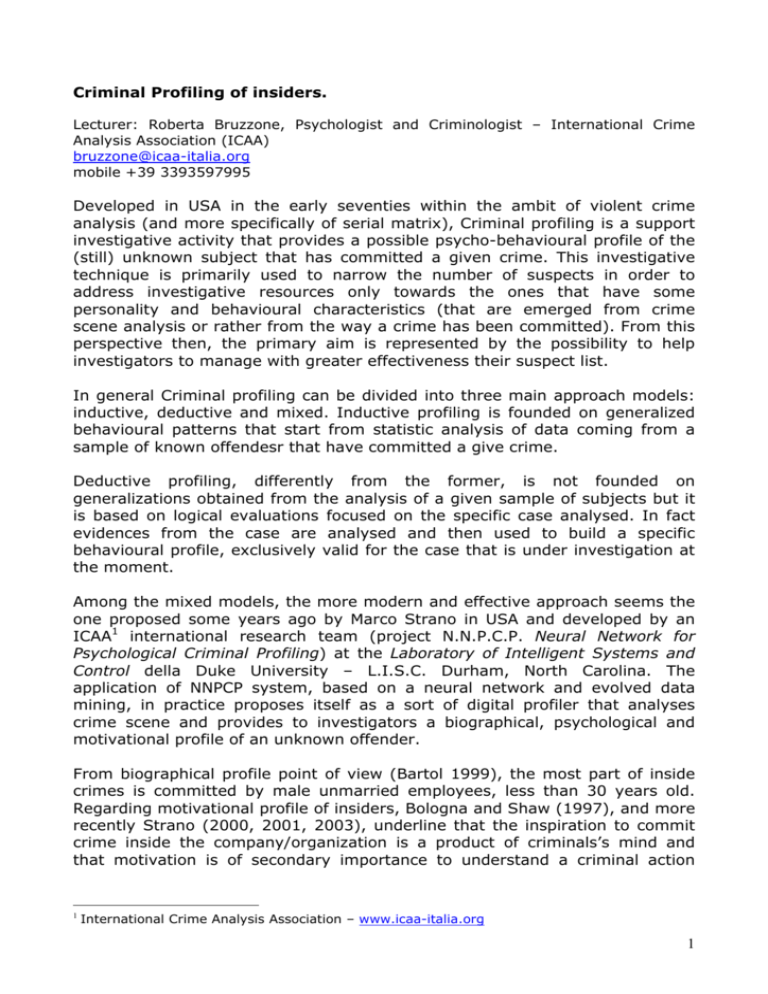1 Criminal Profiling of insiders. Developed in USA in the early
advertisement

Criminal Profiling of insiders. Lecturer: Roberta Bruzzone, Psychologist and Criminologist – International Crime Analysis Association (ICAA) bruzzone@icaa-italia.org mobile +39 3393597995 Developed in USA in the early seventies within the ambit of violent crime analysis (and more specifically of serial matrix), Criminal profiling is a support investigative activity that provides a possible psycho-behavioural profile of the (still) unknown subject that has committed a given crime. This investigative technique is primarily used to narrow the number of suspects in order to address investigative resources only towards the ones that have some personality and behavioural characteristics (that are emerged from crime scene analysis or rather from the way a crime has been committed). From this perspective then, the primary aim is represented by the possibility to help investigators to manage with greater effectiveness their suspect list. In general Criminal profiling can be divided into three main approach models: inductive, deductive and mixed. Inductive profiling is founded on generalized behavioural patterns that start from statistic analysis of data coming from a sample of known offendesr that have committed a give crime. Deductive profiling, differently from the former, is not founded on generalizations obtained from the analysis of a given sample of subjects but it is based on logical evaluations focused on the specific case analysed. In fact evidences from the case are analysed and then used to build a specific behavioural profile, exclusively valid for the case that is under investigation at the moment. Among the mixed models, the more modern and effective approach seems the one proposed some years ago by Marco Strano in USA and developed by an ICAA1 international research team (project N.N.P.C.P. Neural Network for Psychological Criminal Profiling) at the Laboratory of Intelligent Systems and Control della Duke University – L.I.S.C. Durham, North Carolina. The application of NNPCP system, based on a neural network and evolved data mining, in practice proposes itself as a sort of digital profiler that analyses crime scene and provides to investigators a biographical, psychological and motivational profile of an unknown offender. From biographical profile point of view (Bartol 1999), the most part of inside crimes is committed by male unmarried employees, less than 30 years old. Regarding motivational profile of insiders, Bologna and Shaw (1997), and more recently Strano (2000, 2001, 2003), underline that the inspiration to commit crime inside the company/organization is a product of criminals’s mind and that motivation is of secondary importance to understand a criminal action 1 International Crime Analysis Association – www.icaa-italia.org 1 because the latter is often spread even among persons that don’t commit and that will never commit crimes. In other words, motivation (as the need of money, for example) must find a compatible psychological base in order to manage to nourish a criminal action. To evaluate and analyse the motivational base of insider criminals is in any case useful to plan prevention training courses that can have an influence on the social environment, reducing, as much as possible, conditions that can favour a crime. Regarding this aspect, Fischer and Green (1992), Maree (2003) and Lydon, propose some “typical” situations, statistically correlated with crimes committed at workplace (inside companies/organizations and in particular misappropriation crimes): 1.Personal financial difficulties. At the origin of many inside crimes can be placed a period of financial difficulty connected, for example, to reckless investments, to gambling or simply to the craving of a higher standard of living. Some employees in fact steal for the simple reason that they need more money to supplement their income or because at the moment they are crossing a period of particular economic difficulties and want to be able again to pay their bills. 2. Revenge. Employees believe that in some way they have been treated unfairly by their own employers and because they (the employees) don’t have the power or financial means enough to contrast their employers, they commit sabotage or misappropriation crimes to revenge themselves. 3. Inadequate pay. Employees are convinced that they are not properly paid for their work. Instead of negotiating in order to get a rise, they steal money/goods to their employers. Employees justify their actions stating that they have the right to steal because underpaid. 4. Work dissatisfaction. The most part of sabotage, fraud and theft cases are committed by those employees that show dissatisfaction towards some aspects of their own work, above all towards their employer. 5. Feeling of being not esteemed by the company. An important psychological factor that can be placed at the base of insider crimes is represented by the feeling of the employee about the opinion that the company/organization can have about him/her. 6. Psychiatric disorders and drug abuse. Alcohol and drug abuse and some psychopathological disorders can represent a motivational base for insider crime, both of vandalic-destructive type and embezzling type. However this dimension represents a smaller sample of total workplace crimes. Of course these conditions can be detected even in subjects that are very distant from any form of crime. Psychological and motivational characteristics of insiders have been focused by only few accurate studies carried out by some American researchers (Parker, 1976-1998) in the early eighties that have used some classifications based on known insider criminals (that have been detected) and based only on a little sample of cases. 2 These approaches present the risk of generalizations and can say not much about those insiders that have never been detected (that seem to be the most part of active insiders). In Europe the research experience carried out by Prof. Marco Strano’s team, started in the early nineties, is focused on an operating tool for criminal profiling of insiders. This tool tries to reduce systematic errors by proposing a system based on neural network and data mining (IAD System). The ICAA IAD system (Inside Attack Database) As formerly documented by a wide international scientific literature, private companies and Public Administration demonstrate a considerable reluctance to publicize through reports to Law Enforcement Agencies the attacks that they have suffered and in particular the ones defined “inside attacks” (committed by subjects that belong to the organization). This situation has made very difficult scientific research on the topic and, more in general, the circulation of useful information to contrast this criminal phenomenon. The ICAA’s target is to offer to security specialists a new intervention tool that is called IAD (Inside Attack Database). Experimentations to apply NNPCP software (Neural Network for Psychological Criminal Profiling) even to insider crimes have started in 2005 and represent the last born among ICAA research projects in partnership with Duke University and other professional associations that operate in information security sector. IAD system contains data on computer crime inside cases and allows to security specialists and investigators to acquire immediate infooperating elements on different kinds of inside attacks. The system in practice, in the line of NNPCP project, provides to operators a “decisional support” in the investigative phase. NNPCP software, in fact, is able to realize a socio-biographical, motivational and technological profile of the attacker supporting operators in cases of unknown offender. To feed the system, ICAA and AISIC2 have created a sort of security specialists ‘ s “club” that, since years, is feeding IAD system with cases in an anonymous form. Of course, the ones that contribute to train IAD system through real cases can then interrogate it for free in case of necessity. From first application of IAD system are emerged confirmations as regards the fact that insiders normally are included into 3 categories with different characteristics: high profile insiders, low profile insiders and unaware insiders. 2 AISIC (Associazione Italiana per la Sicurezza nelle Informazioni e nelle Comunicazioni) 3







